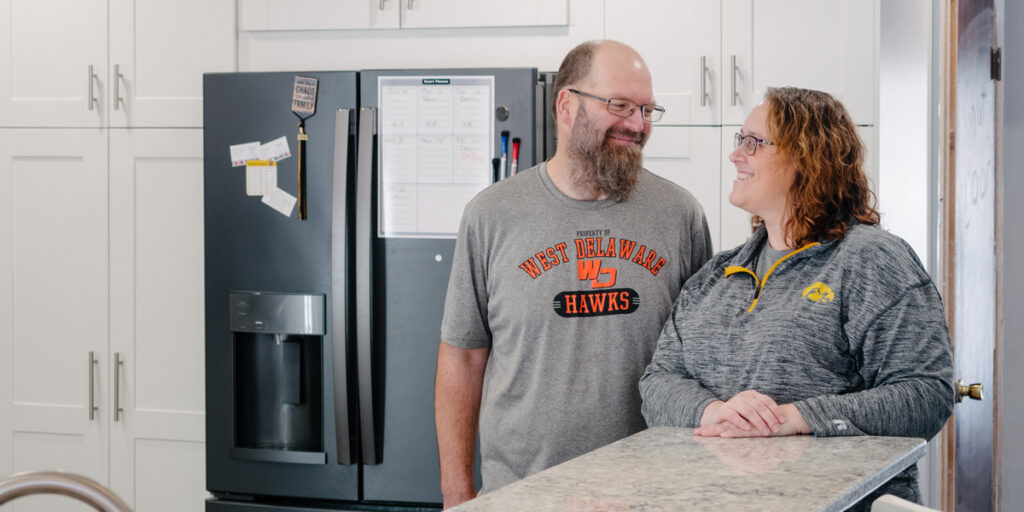
What’s the best way to pay for home improvements?
Thinking about upgrading your home? Maybe you’re dreaming of a brighter kitchen, a more functional entertainment space or finally tackling an overdue repair. Home renovations can be rewarding. But figuring out how to pay for them? Not so much.
Whether you’re planning a quick refresh or a full-scale renovation, finding the best way to fund it is key to keeping your money (and your stress level) under control.
Let’s walk through some of the best ways to pay for home improvements—and save money along the way—so you can feel good about how you’re funding your home’s next chapter.
Here are some of the best ROI home improvements >
Save up before you start
If your upgrade can wait, saving for your goal can reduce the amount you need to borrow. Consider setting up a dedicated savings account just for home projects. This way, you can track your progress and make it feel like real goal, not just a “someday” wish.
Best ways to pay for home improvements
If you need to borrow money for your project, you have options. But they aren’t all created equal. It’s important to choose the best financing method based on your financial situation, scale of your project and how quickly you want to get started.
Here’s a rundown of some common options—and what to consider with each.
Home equity line of credit
A HELOC is a revolving credit line that allows you to borrow money against the equity in your home.
It works a bit like a credit card—borrow what you need up to your limit, pay it off and borrow again while the line is open.
Best for: Longer or phased renovations where expenses roll in over time—like updating your kitchen now and installing solar panels a few months later.
Why it’s appealing
With a HELOC, you can borrow, repay and borrow again during your draw period. You only pay interest on what you actually borrow, which offers flexibility for projects that evolve over time. And since you’re using your home as collateral, it typically offers much lower interest rates than personal loans or credit cards.
Home equity loan or line of credit: Which is right for you? >
What to keep in mind
- Most HELOCs come with variable interest rates, meaning your rate—and your monthly payment—can go up or down based on market conditions.
- Easy access to funds could make it easy to overspend if you’re not careful.
- If you default on your loan, you could risk losing your home. That’s why it’s so important to borrow responsibly.

Home equity loan
A home equity loan lets you borrow a fixed amount against the equity in your home. It’s considered a second mortgage on your house. And your repayment is made in fixed monthly installments over a set term. (At Dupaco, you can make weekly or biweekly payments to potentially pay off the loan even faster!)
Best for: Larger projects where you know how much you need to borrow.
Why it’s appealing
You get all your funds upfront, which can be great for big-ticket upgrades like a roof replacement or full kitchen remodel. Because you’re using your home as collateral, it typically offers much lower interest rates than personal loans or credit cards. Plus, a predictable interest rate and monthly payment could make budgeting easier.
What to keep in mind
- You’ll likely pay closing costs.
- You get all the money upfront, whether you need it now or later.
- Just like a home equity line of credit, your home is used as collateral.
Cash-out refinance
A cash-out refinance replaces your existing home loan with a larger one—and gives you the difference in cash.
Best for: Homeowners who want to refinance anyway or are planning a major project.
Why it’s appealing
It rolls everything into one loan. You could potentially even score a better interest rate or different repayment terms. The lump sum could be perfect for a significant project, like adding a new bedroom or finishing a basement.
What to keep in mind
- You’ll likely need to pay closing costs again.
- A bigger loan means a bigger balance, so consider how it fits into your long-term financial plan.
- If you extend your mortgage, you’ll be repaying that debt even longer.

Home improvement loan
A home improvement loan is unsecured, meaning you don’t use your home as collateral.
Best for: Newer homeowners or anyone without much equity who still wants to tackle a home project.
Why it’s appealing
You’ll get your money in a lump sum. And you can use it for just about any home-related purpose, like replacing your HVAC, upgrading your bathroom, updating your siding and more.
What to keep in mind
- Interest rates tend to be higher since it isn’t secured by the equity in your home.
- Your loan amount may be more limited.
- Repayment terms could be shorter than home equity options, which could mean higher monthly payments.
Credit cards
Credit cards aren’t usually ideal for big renovations, but they could play a part in your project.
Best for: Small purchases you can pay off quickly.
Why it’s appealing
If you’re confident you can pay off the balance before interest kicks in, credit cards can be a handy tool, especially if you can earn rewards for those purchases or take advantage of a promotional period.
What to keep in mind
- Interest rates are often higher after promotional periods end.
- Carrying a large balance could hurt your credit score.
- It can be easier to overspend and go off-budget.
Smart ways to save on home renovations
No matter how you pay, stretching your renovation dollars can make a big difference.
Here are some ideas to help you get the most out of your renovation budget:
- Refine, don’t overhaul: You don’t always need a full gut job. Try painting, updating hardware or refinishing cabinets instead of replacing. A professional organizer might be able to help you optimize the space you have—at a fraction of the cost of a remodel.
- DIY where it makes sense: Consider handling the simpler tasks yourself to save on some labor costs. Just know your limits!
- Choose the right contractor: Get multiple quotes, check reviews and ask for references to ensure you’re getting quality work at a fair price. Learn more about how to hire reliable contractor (and avoid mistakes) with these tips.
- Spend with the future in mind: Sometimes, spending a little extra up front can pay off in the long run. For example, durable, energy-efficient upgrades may cost more upfront but save on maintenance and utility bills over time.
The bottom line
Like any project, it’s easy for costs to climb. Plan for expenses to cost more than you think. And if the project ends up costing less, great!
The best way to pay for home improvements is the one that aligns with your budget, goals and peace of mind. And when done well, it might even increase your home’s value for the future.


